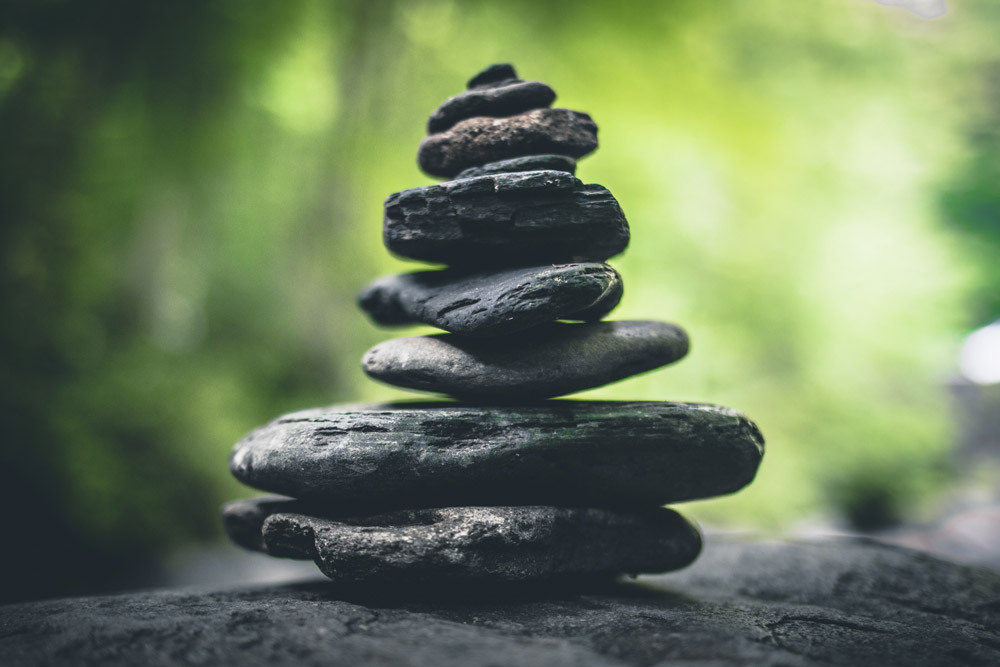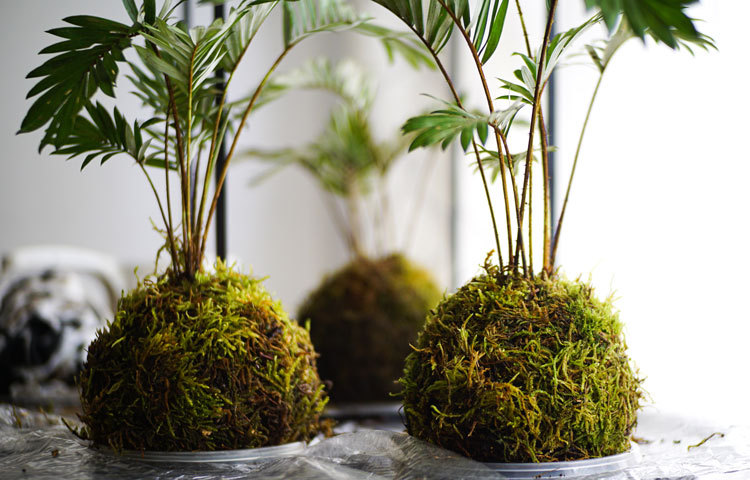What happens when things break? Most of us throw that thing away, but is it time to consider a different approach? One that instead fosters adaptation and embracing flaws.
Western society has led us to believe that it’s best to buy new, continuing our pursuit of perfection. Although we’ve seen climate-change movements and drives towards eco-friendly living challenge consumer habits, many of us have not yet changed our materialistic approach to a more sustainable lifestyle.
Kintsugi – What does it really mean?
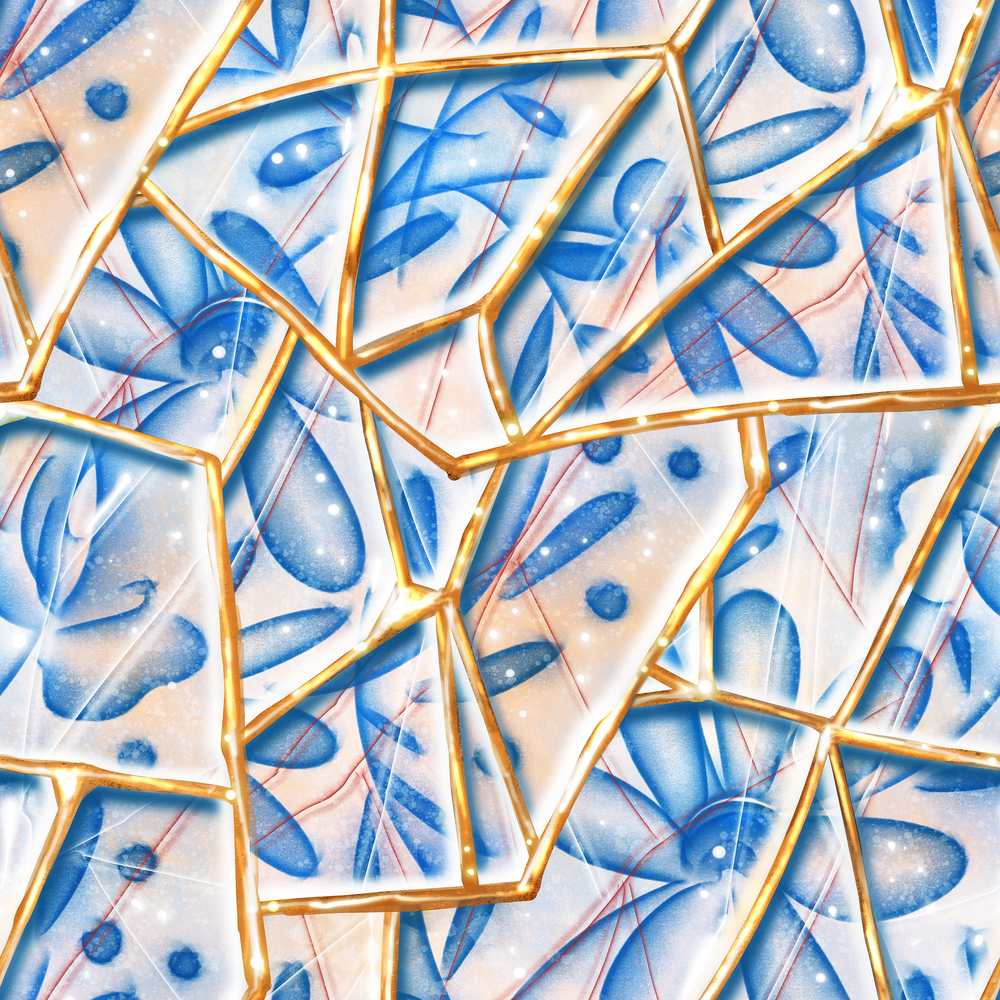
We can look to the east and the ancient Japanese zen Buddhist approach to mending – Kintsugi, for inspiration.
Kintsugi (金継ぎ, “golden joinery”), also known as kintsukuroi (金繕い, “golden repair”), is the Japanese art of repairing broken pottery by mending the areas of breakage with lacquer dusted or mixed with powdered gold, silver, or platinum. The practice teaches us how to fix things beautifully, embracing mistakes and vulnerability with a little bit of creativity.
Origin of Kintsugi
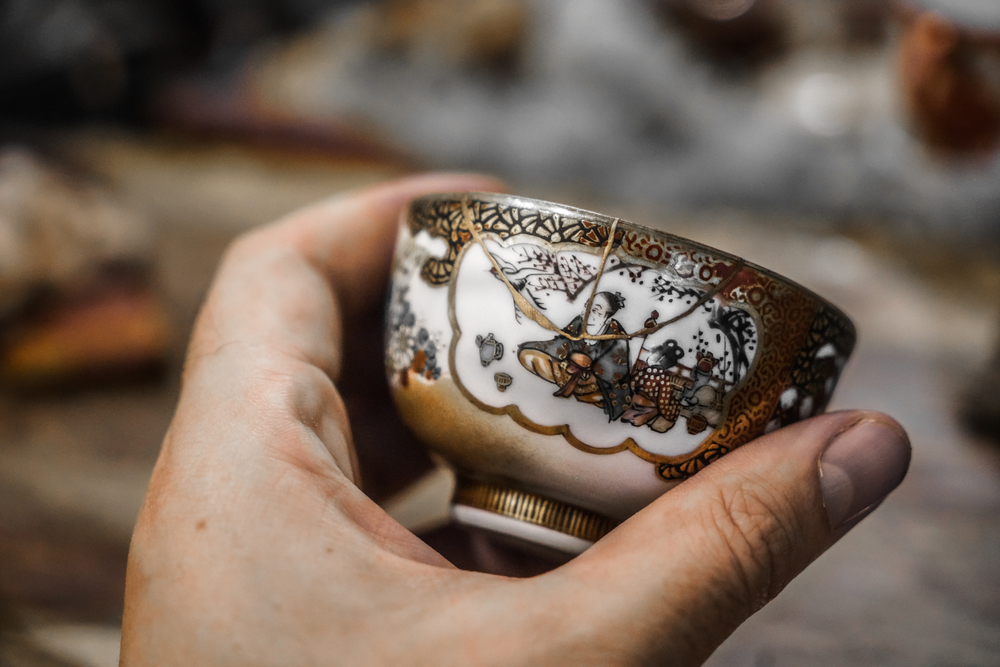
According to art historians, the origin of the practice dates back to the 15th century. When shogun Ashikaga Yoshimasa, a hereditary military dictator who helped promote one of Japan’s greatest cultural eras sent his favourite tea bowl off to be repaired in China. He hoped that it would come back like new, but instead, it came back stapled together. Unhappy with the returned bowl and the metal pins that were fixing the bowl back together, they tried something else. Local artisans came up with a solution — they filled the cracks with golden lacquer. The golden lines added value and charm, making the piece even more beautiful.
After this, it is said that collectors became so fascinated with the new art technique that some were accused of deliberately smashing valuable pottery so they could repair them with the gold seams of kintsugi.

Image Credit: Art & Object
Touching on the word as a whole –– Kin meaning gold and Tsugi meaning joinery –– the name pays homage to how the art itself is made: to literally be joined together with gold. In Zen aesthetics, the broken pieces of the art are first reassembled and then, glued together with lacquer and luxurious fine gold powder.
As such, the entire point of this art process is to not have any attempt of hiding or disguising the damage; instead, it is important to highlight and bring out the fullness of the fault-lines which render beauty and power while gold dust is there to provide emphasis on the philosophically-rich merit of the breaks and cracks.
The Types of Kintsugi
Crack method
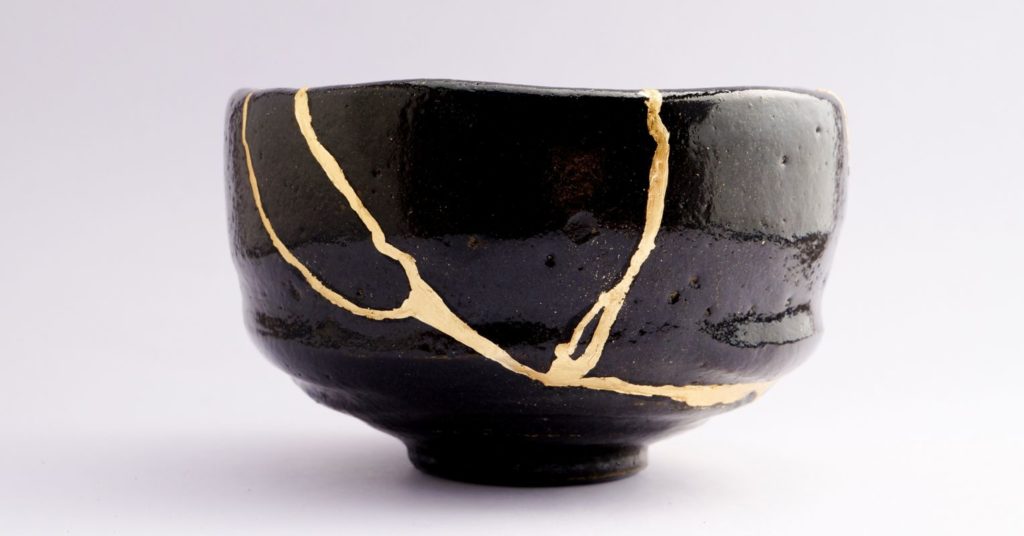
Image Credit: BBC
There are also a few major styles and types of kintsugi manifested through its different types of joinery. The first is the Crack (ひび) method or Hibi. The Crack method is the most common type of style often seen in a kintsugi –– the traditional use of gold, platinum, or silver dust, and resin or lacquer to adhere and fill in the damaged or missing pieces with minimal overlaps.
Piece method
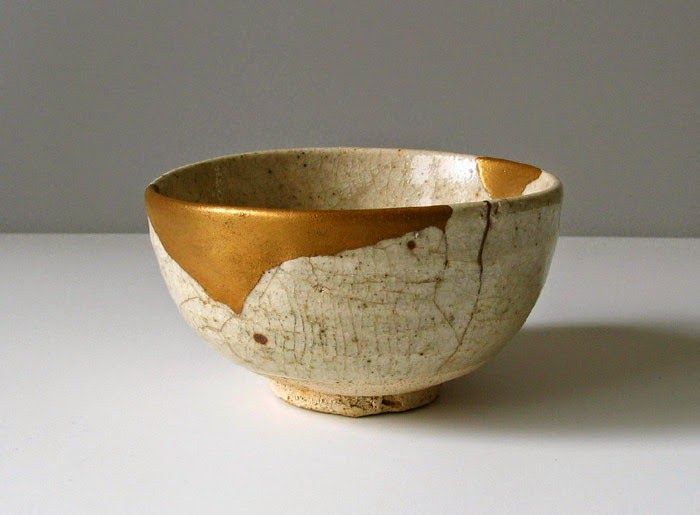
Image Credit: GarMac Studio
Next is the Piece method (欠けの金継ぎ例) or Kake no kintsugi rei. The Piece method, on the other hand, replaces and adds a piece or segment of a missing ceramic fragment with either pure gold or gold-lacquer compound.
Joint Call
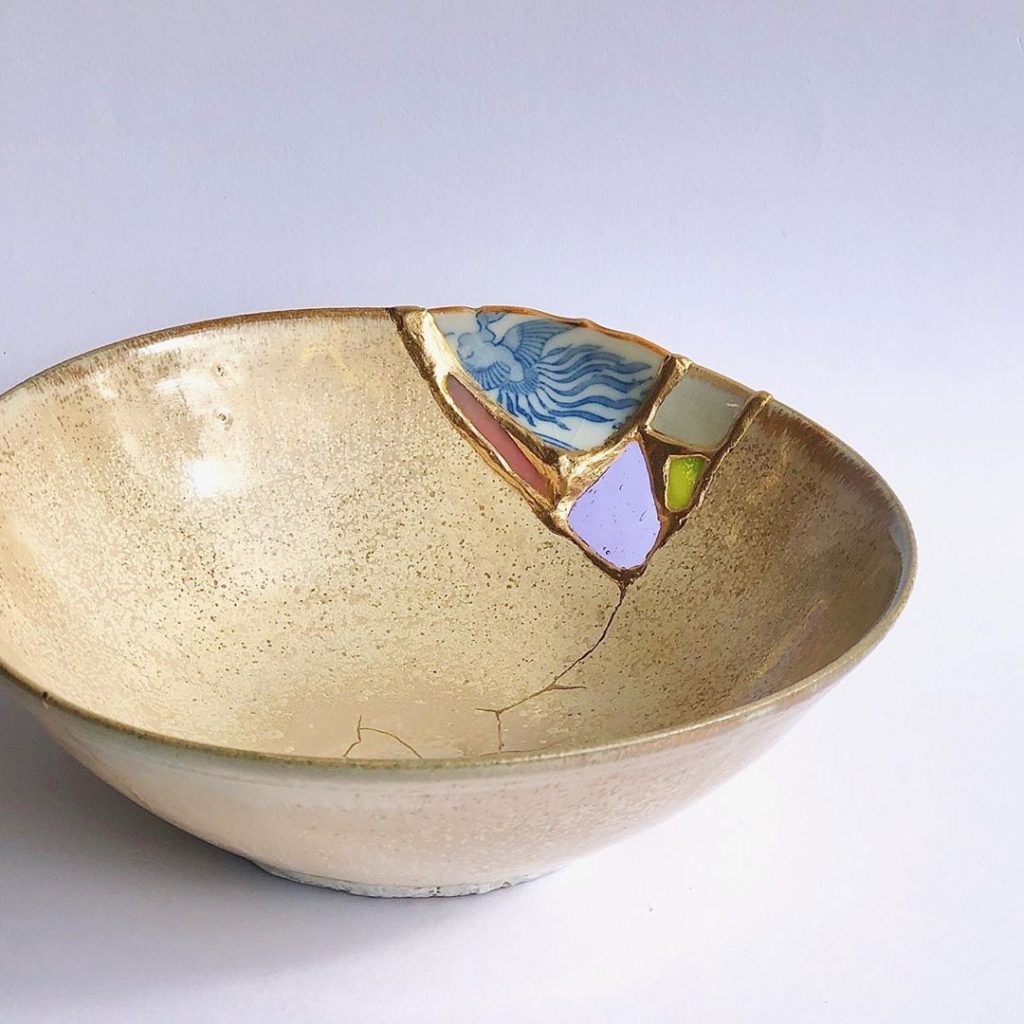
The Joint Call Method (呼び継ぎ) or Yobitsugi involves a similarly shaped but non-matching fragment (either yielding a difference in pattern, design, or colour) is used to cover up the missing piece or ceramic fragment; thus, creating a somewhat patchwork-looking design and effect.
Staple Repair Method
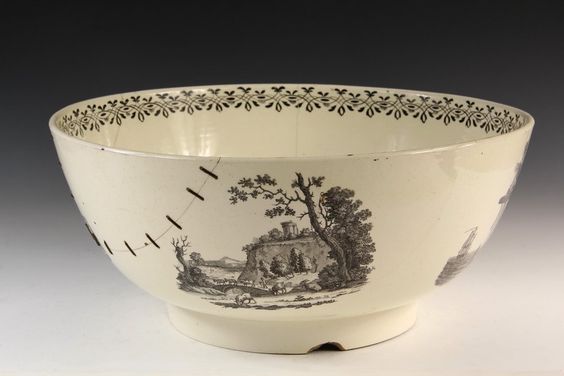
Additionally, another related technique to the previously aforementioned ones would be the Staple Repair method. For this technique, small holes are drilled on either side of the cracks or broken ceramic pieces and are then pieced together using bent metal staples.
This method was often used in Western places such as Europe, ancient Greece, and Russia among others, and was also a well-known repair technique in China, especially for valuable pieces such as porcelain.
The Philosophy of Kintsugi

Kintsugi is not just an art and mending practice – many have found solace in the technique’s philosophy. Pushing aside the idea that everything should be perfect, many people see kintsugi as accepting imperfections and flowing with our mistakes. If we learn to do so, picking up the pieces and putting things back together, these mistakes and flaws can ultimately make us stronger, adding beauty and telling a unique story.
The Japanese philosophy is full of wisdom, for example, wabi-sabi is another similar philosophy that teaches us to embrace the flawed or imperfect. In traditional Japanese aesthetics, wabi-sabi is a view focused on accepting imperfection and can be described as appreciating impermanent beauty.
Although the practice has been around for 500 years, it seems to be picking up in popularity today. You can now buy at-home kintsugi kits to try if you are a keen crafter or are just interested in having a go!
The philosophy is also growing in popularity in recent years and has inspired many other artists and creators. There’s now kintsugi-inspired jewellery, books, art, lego, and even a song named after the practice…
[lasso ref=”kintsugi-embrace-your-imperfections-and-find-happiness” id=”18558″ link_id=”1150″]
Like the lines on our palms, each Kintsugi piece is unique, offering its own story and its own pattern. For an ancient practice, its powerful philosophy and unusual beauty still resonate with people today, inspiring artists, crafters, Japanese culture enthusiasts, and others to think twice about throwing broken pottery away and going with the flow to repair and work with mistakes.
[lasso ref=”kintsugi-the-poetic-mend” id=”18555″ link_id=”1514″]
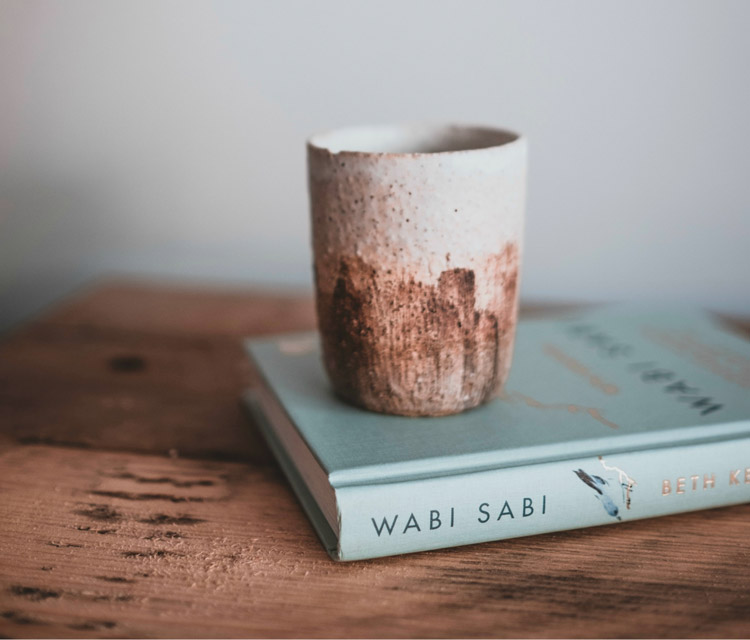
Image Credit: Wabi Sabi Sylvie
Wabi-sabi is generally a Japanese philosophy that promotes the action of altruistically accepting and embracing the flawed and transient; appreciating beauty that is said to be “imperfect, impermanent, and incomplete” in nature.
Looking back at its roots, the world view and aesthetic of the wabi-sabi developed from the three marks of existence (三法印, sanbōin) entailed by Buddhist teachings, specifically accentuating the three subconcepts of impermanence (無常, mujō), suffering (苦, ku), and the emptiness or absence of one’s self-nature (空, kū).
On the other hand, the characteristics of the wabi-sabi concepts and principles include the appreciation of both the forces of nature and natural objects, its roughness and simplicity, asymmetry and variability, and austerity and modesty, to name a few.
Looking at the two words individually, both Wabi and Sabi signify two different concepts: while Wabi puts more emphasis and recognition on the beauty of humble simplicity by detaching ourselves from materialism and worldly objects, Sabi tackles the passage of time and how all things –– used, unused, new, and old –– all grow and age eventually; highlighting how beauty goes beneath and beyond the broken and decrepit surface-level visible to the naked eye.
Putting these two words together thus creates a new philosophy that offers us a glimpse of how we can truly learn to approach life: to live in the present, accept the way things are and how they came to be, and simply appreciate the basic, fleeting stages of what we know as life.
Influence of Kintsugi on Modern Art
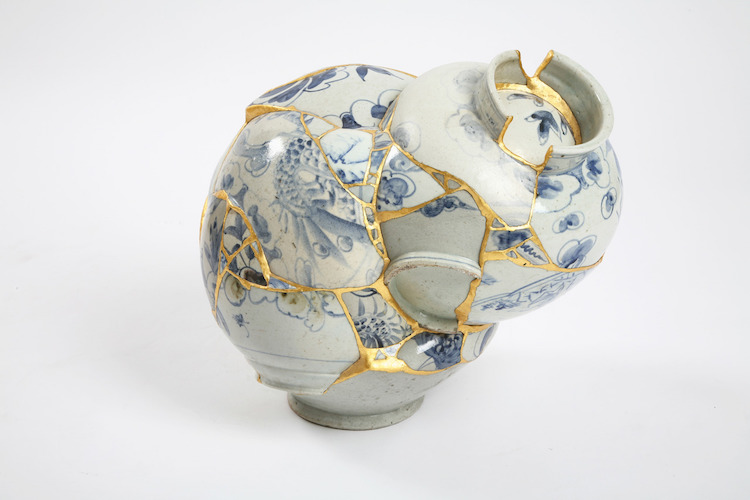
As Kintsugi is generally defined as the concept of emphasizing imperfections and flaws through using its mends as an area to celebrate and focus on, many modern artists and designers have thus utilized the traditional technique to touch on the ideals and concepts of loss, enhancement, and synthesis through exploring the themes of destruction, repair, and rebirth as reflected in the kintsugi.
Although they were originally considered as a separate form of art, the kintsugi has now been gaining modern-day recognition and has already been featured at numerous well-known exhibitions and museums including the Freer Gallery in Washington D.C’s Smithsonian Institution, the Metropolitan Museum of Art, and the Herbert F. Johnson Museum of Art both located in New York.
Consequently, there have also been numerous artists and designers who have integrated the concept of kintsugi in their work. First up is South Korean interdisciplinary artist Yee Sookyung, who made use of kintsugi methods to transform common objects that highlight the balance between the eternal struggles of which we all go through; Japanese potter and ceramist Tomomi Kamoshita who pieces kintsugi-influenced art together using chopsticks, and small, broken pieces of glass and ceramic that she found on beaches; and British artist Charlotte Bailey who created textile works that involved the reparation of broken vases covered by fabric and stitched together with gold metallic thread.
Amid the current pandemic, the practice and philosophies entailed by kintsugi also became a source of comfort and strength to many individuals. The kintsugi thus became a metaphor of being able to rise once again after experiencing tragic events such as loss, sickness, trauma, and ultimately, the disruption of life as a whole.












































